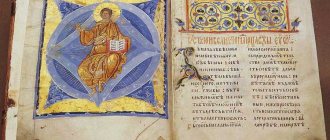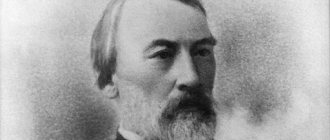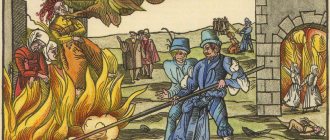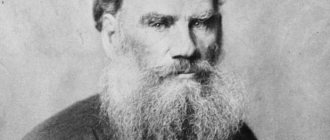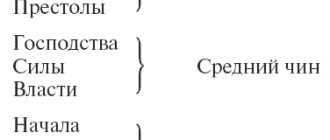In modern society, the word “crisis” has become so common that it has largely lost its meaning. Scientists and publicists talk about the crisis of civilization; articles and monographs are written about it. Having discussed this problem for quite a long time, we have gradually become accustomed to thinking that we live in a state of crisis.
This crisis is manifested in many areas, the negative processes are obvious, a lot is said about them: this is the almost complete loss of moral orientation, especially among the younger generation, these are various social ills that have become almost commonplace - a sharp increase in the number of people suffering from alcoholism and drug addiction, number of suicides. Despite all the efforts of law enforcement agencies, medicine, public and religious organizations, the diseases of society are rapidly spreading and intensifying throughout the world.
All this indicates that a crisis of civilization is indeed taking place. What civilization? I believe, the one that has developed over the last century: it is usually called “post-Christian”. This very word contains a deep untruth, because “post-Christian” is, as it were, a civilization that came “after Christianity”: that is, it is assumed that Christianity has successfully outlived its time and some other era has begun.
This is wrong. Christianity, the Church, are the same as Christ Himself—the same yesterday, today, and forever (see Heb. 13:8). Today, like many centuries ago, people come to churches, meet the Living God, and take the path of salvation. But that part of humanity that not only forgot Christianity, but deliberately renounced Christ - it did everything to prove to itself and the world that the profession of Christianity has nothing to do with today. It is this civilization, anti-Christian in essence, that challenges not so much religion as itself, deliberately violating the basic principles of the relationship between man and God, which is actually the cause of the deepest crisis.
The fact is that man as a biological, social object, using technical terminology, “does not imply existence in such a regime”: man cannot live without God! Tertullian's words that the human soul is by nature Christian are very accurate. And if the bulk of humanity renounces God, begins to resist Him, and even more so challenges its Creator, such a civilization is doomed.
Even if we leave aside the religious component of the problem, a civilization that proclaimed hedonism, the cult of pleasure as the ultimate goal of human life, also cannot exist for a long time, because it is simply unviable.
History teaches us several similar lessons; among them is the collapse of the great Empire: the Greco-Roman civilization fell precisely because it bowed to the idol of hedonism. A society enslaved by the cult of pleasure loses heroism, self-sacrifice, a sense of responsibility - everything that seems “superfluous”, unreasonable, ideal.
It is also necessary to remember Bazarov’s “burdock on the grave”: from it grows a disdainful attitude towards Christianity in modern Russia; its roots are in the crude positivism of the second half of the 19th century. Our contemporaries only picked up and developed to the extreme the thoughts that were quite naive, stupid and impudent, which seemed to be the “great rise” of human thought a century and a half ago.
I really liked the words of Deacon Andrei Kuraev (and this is an author who loves paradoxical statements) that atheism is a dead-end branch of evolution; after all, atheism is also one of the most characteristic features of the civilization we are talking about: atheistic, anti-Christian, hedonistic. And we are truly living in a period of crisis.
***
How does this affect Orthodoxy? Does it change over time? Yes and no.
From the point of view of the history of the Church, of course, changes have occurred and are occurring. Thus, at each Ecumenical Council, dogmatic definitions were developed, one or another side of Revelation was revealed, which before that, perhaps, remained in the shadows. Church practice and forms of church art change over time. From such positions, one can talk about Orthodoxy of the 21st century, the same way, for example, as about Orthodoxy from the times of the Roman Empire, or Byzantium, or Ancient Rus' - each time period has its own characteristics. And the external features of our existence, the language of preaching, the problems of spiritual life, of course, are connected with the way of life that a person leads.
On the other hand, Orthodoxy is unchangeable, since it is God’s Revelation of Himself. It is unchangeable, just as God Himself is unchangeable. His attitude towards man does not change, what He expects from His most perfect, beloved creation.
Therefore, we can say that in the Church there is temporary and eternal. In general, a Christian is a person who recognizes himself as standing before the face of God, before the face of eternity. It is precisely this—eternal—side of the life of the Church that the secularized world cannot understand and accept, reproaching the Church for conservatism and archaism.
These concepts themselves are not equivalent. The Church is truly conservative in the first sense of the word (conservative - defending immutability), without any negative connotations. The true conservatism of an Orthodox believer is manifested in fidelity to Christ, in conscious and constant adherence to the Gospel commandments.
The de-churched world puts a different meaning into the concept of “conservatism”: “that which pulls back into the irretrievably gone past.” It is not difficult to notice that in the “system of coordinates” of a society that deifies progress in the field of technical achievements of the human mind, there is no place at all for “eternal values.” Any reminders that the basis of human existence are feelings of love and fidelity, and not the currently dominant slogan “Take everything from life!” seem “untimely” to him. The denial of anything eternal in principle - and the Church is called upon to tirelessly remind people of eternity - gives rise in the secular world to a sharp feeling of rejection towards it.
Archaism is a different concept; it is an “internal” danger of the Church; it arises where blind adherence to external traditions and a predilection for the archaic in church life are manifested.
There is an example that the Lord allowed for our understanding - the Old Believers. There are sundresses, caftans, and loose-fitting scarves. There is strictly canonical iconography, there is magnificent spiritual singing without any Italian partes... In general, there are many good and good things, but there is no Church. This is especially obvious among the priestless people, who refused to celebrate the Divine Liturgy and replaced the Sacraments with customs. This is the logical conclusion of the path of following the requirements of the archaic, an example of the fact that external traditions, in general, something external can really obscure Christ and hide the truth.
Traditions are just a vessel that must retain life-giving moisture, for this reason it was made. But if this is a very beautiful, precious vessel, there is a great temptation to take care that moisture “does not interfere” or spoil the product - pour out its contents, and carefully wipe the vessel itself, put it in a place of honor and protect it. But does an empty shell retain its meaning?
“What is most precious to you about Christianity?” - the central question of the work of the philosopher V.S. Solovyov "Three Conversations". “A Brief Tale of the Antichrist” contains a brilliant insight - a situational model that points to certain pain points in the Christian consciousness. Those for whom “the old symbols, the old songs and prayers, the icons and the order of worship” are most important are being deceived by choosing the “World Museum of Christian Archeology” instead of the living Church, the Body of Christ. I think every person needs to get acquainted with this work in order to approach the issue of the relationship between the external and the essential sensibly, soberly, “with reasoning”; do not try to reduce Orthodoxy to an ethnographic set of rituals and traditions, much less restrictions and prohibitions.
Arsenyev N.S. On the modern situation of Christianity. Magazine "Path" No. 7
Author: Arsenyev Nikolay Sergeevich
N.A. Berdyaev called our era the brewing “new Middle Ages.” I think it would be even more correct to point out that the trends of early Christianity are again sweeping across the world. Religious renewal begins little by little, in little noticeable ways, in different parts of the world. Streams of grace-filled life always flowed without interruption, but many now came to them who had previously shunned them. The mustard seed of the Gospel has again fallen into the soil, loosened by war and terrible world upheavals, and it is still growing little noticeably, but already in an effective way.
An atmosphere of religious tension is spreading more and more - not exaltation, but a feeling of the closeness of the Lord, not the eschatological nearness of the Lord coming in the second coming (for what can we know about that?), but the closeness of the Lord walking the path of history. “Look at the fields, how they have turned white and are ripe for harvest,” the Lord said to His disciples. If we look closely, we will see that behind the decorations of the political proscenium, the harvest of the Lord is maturing and being prepared.
Those who experienced religious events in Soviet Russia know that in many there this harvest is already ripening, perhaps this harvest has already ripened. There Christianity again revealed itself as a victorious force, with such brightness with which it may not have been revealed since the times of the ancient Apostolic Church. There are many apostates, many who have fallen, much that is humanly unworthy, but in the midst of this the power of God has been revealed, supporting those who remain faithful. It was felt that the Kingdom not of this world was stronger than the Kingdom of this world; that “madness for Christ’s sake”, that “the foolishness of preaching” is a force that captures hearts; that the words: “Behold, I am with you always, even to the end of the age” are not just words, but a promise, the truth of which was especially felt in the throes of persecution. “We are oppressed, but we are sedate; we are in desperate circumstances, but we do not despair; we are persecuted, but we do not abandon; we are cast down, but we do not perish. We always carry in our body the deadness of the Lord Jesus, so that the life of Jesus may also be revealed in our dead flesh.” These paradoxical words, testifying to a new, different plane of spiritual existence, written by Paul in his letter to the Corinthians 1870 years ago, turned out to be true, a vital truth even now. It is important to realize this, it is important to understand that Christianity has appeared fully armed again, as a victorious force, in order to feel the full significance of our time. All the words of the apostle: “Now is the time of favor, now is the day of salvation,” “Let us therefore be clothed with an instrument of light,” “The Day has come”—concerned all believers always and everywhere, for it is always close, at the door: “Behold, I stand at the door of the heart and I'm knocking." But there are times when believers can hear the voice of God especially clearly, when the words of the apostle sound especially insistently: “Put on the whole armor of light.”
Christianity is not ashamed even now of the foolishness of preaching: “for when the world through its wisdom did not know God in the wisdom of God, it pleased God through the foolishness of preaching to save those who believe.” As for the Athenian philosophers on the hill of the Areopagus, so now the main stumbling block for the sages of this world is the sermon about the risen Christ, that is, about the Victor over the lifeless, soulless icons of the world. But this is precisely the main strength, this is the whole essence of Christianity, the whole essence of Christian preaching: “for life was revealed, and we have seen, and we testify and proclaim to you this Eternal Life, which was with the Father and was revealed
99
us". “If Christ is not risen, then our preaching is in vain, and our faith is also in vain... But Christ is risen, the Firstborn of those who died.” This is the whole soul of Orthodoxy.
The Treasure of Eternal Life was revealed to the world. But too often we forget about it and now humanity again seems to be brought to it. The truth, the vital, real, victorious truth of Christ’s Resurrection was revealed to us with special force amid the torment and persecution of the Soviet system. And for Western Christianity, the risen Christ is increasingly again becoming the center of the life of faith. That is why they are so drawn to the spirit of Orthodoxy, full of joy in the Risen One - those many deeply believing Catholics and Protestants who do not leave their Church, but who joyfully see that they are increasingly united with us and with early Christianity in the central and main thing, in our common heritage and treasure, in joy in the Risen Lord. Thus, one pious Catholic monk (German Benedictine), in a letter to the writer of these lines, admiringly cites the following passage, which he accidentally encountered in an ancient life: “The day has come, the fulfillment of times, and the crown of the year, the feast of feasts, the beginning of the general resurrection (initium universalis resurrectionis), the resurrection of Christ our God, to whom heaven and earth sing a song of victory (“cui triumphalem hymnum canunt coeli et terra” vita S. Eutichii, Acta Sanctorum, VI April, t., I. 567).
In the Journal "Una Sancta" Pastor Glinz (from Northern Switzerland) never tires of emphasizing the centrality of the resurrection. Two remarkable holy figures in Protestantism of recent times, to whose posthumous voice many believing circles of modern Protestantism increasingly began to listen, the Blumhardts, father (1805-1880) and son (1842-1919), place precisely the risen Christ, purely in the spirit of the apostolic sermons, at the forefront. Blumhardt's father yearns for “the emanations of the glory and grace of the Risen Jesus Christ” (Ausstrahlungen der Herrlichkeit und Freundlichkeit Jesu Christi des Auferstandenen).*) The whole atmosphere in which he lived and died, writes his biographer, was an atmosphere of resurrection. *) Blumhardt's son speaks again and again in his sermons about this fundamental and most important thing - about the resurrection of the Lord. “What is the center, what is fundamental in the Kingdom of God, the focus of everything?” - he asks and answers: “Resurrection! The revelation of God in the resurrection from the dead." What in the world could confuse and oppress him when he knows that Jesus is alive, risen from the dead? “Neither temptation, nor tribulation, nor sickness can frighten us: Jesus lives and has risen from the dead.” Only the power revealed in the resurrection, only the Risen One, possesses dominion over the world.**)
The Christian Hindu mystic Sundar Singh, who made a great impression especially on many Protestant circles of the Western world, made the gospel of the Living and Risen Conqueror of death the center of his missionary preaching.”***)
Catholicism, which is now experiencing, especially in Germany, a period of self-deepening and a new flowering of the spiritual ****)
________________________
*) Given in the book E. Jackh-a Blumhardt Vater and Sohn, Berlin 1925, Furche-Verlag pp. 41.
*) Given by E. Thurneysen-a, Christoph Blumhardt, Munchen Kaiser. 1926, p. 39.
About Blumhardt-ahsm. more next books: Frieder Zundel Johann Christoph Blumhardt (father) ein Lebensbild, L. Ragas, Der Kampf um das Reich Gottes in Blumhardt Vater und Sohn und weiter, Rotapfel-Verlag, Munchen, 1922, followed by the publication of sermons of Blumhardt's son: “Predigten und Andachten von Christoph Blumhardt aus den vershiedenen Abshnitten seines Lebens, hrg. von Lejeune, 1926, Rotapfel-Verlag, Munchen.
**) E. Jakh p. 84.
***) OSundarSingesm. track. books by F. Heiler “Sadhu Sundar Singh. Ein Apostel des Ostens und Westens" 4th ed. (1st ed. 1924), Reinhardt, Munchen: “Apostel oder Betruger? Dokumente zum Sadhu - Streit", 1925; “Christuszeuge oder Hysteriker? Neue Dokumente zum Sadhustreit" (just came out).
****) Compare, for example, the collection “Die Ruckkehr aus dem Exil. Dokumente zur Beurteilung des deutschen Katholizismus der Cegenwart, Vg. von Karl Hoeber, Dusseldorf.
100
in the person of many of their best representatives, they strive to return to the psychology and worldview of the ancient Church. In contrast to scholastic formulas, which harmoniously form a logically developed system (although without denying the formulas), these representatives emphasize what is fundamental and fundamental with which souls were mystically captured in the preaching of early Christianity and which to this day is the basis of the worldview of the Church. This brings them especially close to the spirit of Orthodoxy. From this fundamental thing, from the incarnation and resurrection of the Lord, the illumination of earthly life, the grace-filled life of the Church, the power of the sacraments, and the transformation of creation in the risen Lord become clear to the eye.*)
These trends—the aspirations of the transfiguration of creation, the belief in the sanctification of corporeality through the Lord who accepted the body—are increasingly capturing wide circles of Protestantism. God is not poorer than the world, but richer; in Him nothing perishes, not even material things, for “all creation awaits with hope the revelation of the Glory of the sons of God” and this is the meaning of the resurrection of the Lord in the flesh - such words, even in Protestantism, of both “liberal theologians” and dogmatists (even believers) of the old school with their one-sided “Verinnerlichung” - the subjectivization of religion - are, however, no longer a voice crying in the wilderness in Protestantism.
The writer of these lines has repeatedly spoken before Protestant and Catholic audiences in Germany with an attempt to present (without any polemics) the spirit of Orthodoxy, which is a continuation of the spirit of early Christianity, the spirit of the ancient Church, and met with sympathy not only from Catholics, who heard in this presentation deeply related to them tone, but also among Protestants, even among pastors, and especially among young people, for example, students of theology. “DieLeiblichkeitistdasEndederWegeGottes”, the words of the old Protestant mystic Octinger (18th century), no longer sound wild for the present time.*) Religiously minded people begin to value both body and matter from a religious point of view, from the point of view of Christian realism. (And the worldview of early Christianity and the worldview of the Orthodox Church can be called Christian realism). For the Lord became incarnate - this means that the body and matter in Him are sanctified, and they will take part in eternal life - this is the meaning of the resurrection. When the Orthodox speaker at the philosophical congress in Darmstadt, in September 1924, had to talk about the power of Eternal Life, expressed in the resurrection of Christ in the flesh from the dead, the correspondent of the Tag newspaper, who wrote a report on this congress, was amazed how an educated person could do so naively and directly speaks of the resurrection in the flesh. In Barth's book on the resurrection ("Die Auferstehung von den Toten", 1924, comments on the 15th chapter of the 1st Epistle to the Corinthians) the resurrection is spoken of so carefully and vaguely that the impression is that it is not a fact, but only an idea .**)
But we have already seen that not everyone is so inclined in Protestantism. Christian realism of the flesh breathes and lives on every page of the magazine “Una Sancta” - the organ
__________________
1926 L. Schwann; Hermelink, Katholizismus und Protestantismus der Gegenwart, 3rd ed. 1925, article N. Getzeng “Der deutsche Katholizismus nach den Kriege.” (in “Una Sancta”, 1926, Heft III, p. 277 ff.).
*) Wed. especially the books by Ildenfons-a Herwegen-a (abbot of the monastery of Maria Laach) and Romano Guardini.
*) They are quoted as great Christian truth by Jackh in his book about the Blumhardts and Ed. Thurneysen - one of the most leading figures in modern Protestantism - in his book about Blumhardt son. In general, it should be noted that there is an increased interest in both Oetinger and the Catholic Baader and those close to them in spirit, which is expressed in the republication of their works and in the compilation of an anthology from them. Thus, in the “Dom” series, selected works of Baader were published, and now a republication of the complete collection of his works has begun. I now have at hand a reader from the works of F. Chr. Oetinger entitled: “Die heilige philosophie”, Munchcn 1923, Kaiser.
**) “Die Auferstehung Christi wird zu einer unbestimmten futurisch eschatalo-gischen Grosse welche nur dialectisch erfassbar ist”, this is how Friedrich Heiler characterizes this point of view of Barth (Fr. Heiler. EvangelischesHochkirchentum” in “UnaSancta” 1926, Heft 1 p. 50. )
101
ideas of universal Christianity, which arose, however, in pious evangelical circles striving for the fullness of the church worldview and church life. Already the Blumhardts, father and son, did not tire of repeating about the sanctification of all humanity, soul and body, in all circumstances of his life: “The Lord wants our soul, not only our spirit and not only our thoughts, - He wants our entire earthly being, as it is expressed in our breathing, our eating and drinking, and in all bodily things,” says Blumhardt the son. *) For “in Christ the human being is enlightened,” writes Blumhardt the father.**) There was a connection here with the tradition of Oetinger and other Protestant mystics of his school.
Moreover, the youth movement - Jugendbewegung - consisting in Germany of the most diverse streams and trends, is fundamentally a desire to return to a broader, richer internally, more meaningful, more ebullient and inspired life, as opposed to spiritual philistinism. This Jugendbewegung captures both religious and officially external circles, seemingly far from religion. But there is one thing in common: idealism, impulse, pathos of a return to nature (the famous Rousseauism), rehabilitation of nature. Where it is comprehended and enlightened religiously - in a Protestant or Catholic environment - fertile soil is obtained for the development of Christian realism, for the acceptance of faith in the transfiguration and rehabilitation of creation through the incarnate and resurrected Son of God. The leader and representative of the ideology of the Catholic part of this young movement in Germany - der "Quickbornjugend" (so named after the place of their annual meetings) - was a deeply religious and spiritually burning man, professor of Catholic theology Romano Guardini, himself a man of a young soul and joyful inner uplift, who in the mystical life of the Church he sees the beginning of the transformation of creation, the continuation of the saving and sanctifying work of Christ. More and more Catholics see in this the essence and center of the Church’s worldview; thus they are close in spirit to us, for the transformation of creation through the power of the incarnate and risen Lord is the content of Christian preaching, is the content of Orthodoxy.
However, this is not a new truth for Catholics either; The only significant thing is that now it has again occupied in the minds of many, as it should, a central, fundamental place, as the essence of the Christian gospel.
This gospel has captured—I have already said—many Protestant circles of religiously minded youth in Germany. Hence, for example, the fascination with the poetry of the old romantic Eichendorff, its religious enlightenment of nature in some student and student circles in Germany (the student organization that has newly emerged in many universities (“Gild Skuld”) is strongly influenced by the religious romance of Eichendorff. )
Ideas of religious enlightenment of the world and life - including the surrounding Nature - are developed, for example, in the magazine "Der Weisse Ritter", one of the organs of the youth movement. A powerful youth movement, religiously based, is characteristic not only of Germany, but also of other countries - for example. for France, partly for Poland, but in Germany it is often, so to speak, metaphysical - more striving for a holistic, comprehensive worldview.
In this movement of youth in Germany there is, of course, also a lot that is very wild, strange, even ugly and ugly-caricatured. But - we have seen - even this, brought within limits, can become the basis for a Christian attitude towards the world and life.
Deeply rooted in Christianity, moreover, fundamental, decisive for Christianity, is religious experience, religious knowledge awakening with new force in the hearts and exciting the Protestant world. The world is not autonomous, and not only alien
______________________
*) “Er will unsere Seele, nicht nur unseren Geist, auch nicht blos unsere Gedanken, er will das tiefste irdische Wesen, wie wir es haben in unserem Atmen, in unserem Essen und Trinken, in all den leiblichen Dingen”... given. Jackh, Blumhardt, Vater und Sohn, und ihre Botschaft, 1925, p. 216.
**) Given in the same place, page 64.
*) “Union (or Brotherhood) of the Future” Skuld - Norm of the Future according to the Edda.
102
To God: it must be sanctified, like our whole life - private and public - although we are sinners, we must strive for sanctification (in contrast to the view so widespread in Lutheranism, especially German, and now strongly emphasized by intolerant Lutherans that religion should not have anything in common with public life, that public life - in particular national life in its national tasks - is completely autonomous.*) No, my life, and the life of my family, and our daily life, and the life of my people and all people in general and the goal to which my people and every other people strives, and every creature, and the whole world in its final development must be sanctified. Who sanctifies us? He who sanctifies us is the Spirit of God, given to us if we are faithful to Him who called us. But it is not given to everyone taken individually, but given to the communion of all in love—the communion of the Body of Christ. The Holy Spirit, living in the great organism of the Body of Christ, again becomes a living reality - either as an object of search, or as an object of experience - for many who have forgotten about Him, who have forgotten about His power operating in the Church. The Blumhandts—both father and son—appeared in 19th-century German Protestantism as fiery harbingers of the Holy Spirit. Blumhardt - the father resumed, among other things, in his personal practice the ancient Christian practice of the prayerful laying on of hands, which had disappeared in Protestantism.
Especially now, after the war, when religious demands have awakened with great force and at the same time it has become clear where extreme individualism has led Protestantism (especially Lutheranism), the eyes of many, many in the Protestant world are opening to the significance of the conciliar principle: the Spirit of God blows among the brothers, united in Christ by love. “The rediscovery of the Epistle to the Ephesians” is what Hans Ehrenberg calls**) this is the opening of eyes to the teaching of the Apostle Paul about the Church, or rather to the mystical experience of the Church, which had become completely alien and incomprehensible to Protestantism.*) And now the true thirst for the Church, the thirst for churchliness awakened in the Protestant world (and not only in Protestantism, but also in many who were registered and lived in the Church, but did not know it enough). Pastor Glinz characterizes this thirst for the Church as follows: “Das Wiederwachen der Kirche in den Seelen und die damit zusammen hängende Wendung beträchtlicher Teile der heutigen Christencheit zur Kirche” - “the awakening of the Church in souls and in connection with this the turning of significant parts of the current Christian world “backwards” or rather forward - to the knowledge of the Church. one main theme: “Kirche zu suchen und sich verpflichtet zu fühlen, an ihrem Ban mitzuarbeiten” (“Seek the Church, and feel it is your duty to participate in its construction”), and this left the stamp of the search for the Church on the entire congress.***) A In the organ of this union, which is also the organ of a number of other positively Christian pedagogical unions of German Protestantism, in the magazine “Schule und Evangelium” we read the following significant words: “In our time, especially in the Christian-tinged youth movement, there is a deep yearning for the Church (“lebt”) eine tiefe Sensucht nach Kirche"). From this yearning it becomes clear to us to what extent we have lost the Church, and how little our evangelical Christian world knows what the Church is and how
______________________
*) Typical, for example, is the book: Gerh. Ritter. Luther. Gestalt und Symbol, Munchen 1925, where this point of view is attacked with great energy.
**) Article in the Magazine "Christliche Welt" 1925
*) “Die Kircheistfuruns ProtestantenetwasNebensachliches”, said, for example, not so long ago to Friedrich Heiler, one of the leading liberal theologians of modern Protestantism (quoted by Heiler in his article in “Evangelisches Hochkirchentum “UnaSancta”, 1926. Heft I p. 39).
**) Gost. Ad. Glinz. "Vom Wiederwachen der oekumenischen Kirche", in "Una Sancta" 1926, Heft I, p. 32.
***) See the report of this congress in UnaSancta 1926, HeftIII, p. 344.
103
All our thinking is little guided by the church point of view.”*)
Not only a thirst for the Church, but often a definite search for the Church. Therefore, Khomyakov makes a great impression on many Protestants when they meet him. So in Berlin, in February 1926, in a series of five lectures organized by the Protestant “Ausschuss für innere Mission”, there was a lecture on Khomyakov, given by a Russian speaker). Therefore, the “Hochkirchlich - Oekumenisher Bund” and its organ journal “Una Sancta” could arise. Therefore, Heiler (a former Catholic, now a Protestant) could write: “In the end, this is one idea that has now captured the entire Christian world, or rather: not just an idea, but a divine reality, the reality of the One Church of Christ, which is His creation, His Body , which is He Himself." But “it is impossible on this earth to be able to communicate with the “Invisible Church” (“Ecclesia invisibilis”) if the “Visible Church” (“Ecclesia visibilis”) consciously turns its back: for the mystery of the mystical body of Christ also includes the fact that it perceives a tactile form … The modern Protestant teaching about the invisibility of the Church is a rationalistic abstraction, still rationalistische Verdünnung, which abolishes the idea of the Church of the first Christianity. “The visibility of the Church is due to the incarnation of the Son of God.” Therefore, “you cannot be a Christian without having the Church, and whoever really has the Church also has Christ.” And at the same time, “the fullness of truth is never possessed by an individual apostle, teacher, saint or reformer - it is possessed only by the entire Church, which, according to the words of St. Paul is the Fullness - Filling all in all.” (Eph. 1:23).**)
Heiler in this case is indicative: he, as a person with an unusually sensitive religious soul, guesses where the soul of a modern religious seeker is drawn: not to individual bliss in God, but to the communion of love in God, to unity with brothers in God, to the body Body of Christ.
The German religious world deeply experiences this need and tries to theoretically understand it, substantiate it, and make it an integral part of its religious consciousness. The seeds of this preaching of churchliness are definitely already sprouting in Germany—I am speaking, of course, about the Protestant environment. Young people, theologically interested, are drawn in universities, on the one hand, to extreme individualism and to the separation of God from the world in the teachings of Barth, on the other hand, precisely to churchism, to the idea of communion in Christ. Hence the sympathy for our Church, sympathy for her suffering, indignation against the persecution of her, admiration for her inner beauty, for her spirit of communication and freedom. I, for example, received a letter of this kind from a young Protestant philosopher and theologian from Marburg who had just completed his course, and another, even more touching, on the same topic from an elderly judge from Würtsmberg. It is even planned to create an Orthodox community of the Western rite with a German language in Berlin. A movement similar to the Oxford Movement in the English Church and increasingly approaching in spirit to Orthodoxy has awakened in Protestant Germany. And together with the awareness of the necessity of the Church, together with the understanding of pathos, beauty, and, moreover, the soul-conquering power of communication in the body of the body of Christ, the dream of the unification and rapprochement of all Churches awakens with special force in the Protestant and Anglican environment. This dream lives and is effective to no less a lesser extent in the Catholic world, which is quite understandable, but there it was too often painted in a centralist coloring - in the desire not only to come to the unity of confession, but also to subordinate other Churches to Rome.
Especially many steps towards bringing the Churches closer together have been made recently. And here, in this work of love, various Christian church societies, various church leaders, filled with the spirit of a truly Christian impulse, labored and labor. The late Cardinal Mercier, Archbishop of Uppsala Nathan Saberlom,*) led
______________________
*) Quoted in "Una Sancta" 1926, Heft III, p. 345.
**) Friedrich Heiler “Evangelisches Hochkirchentum”, in “Una Sancta” 1926, Heft I pp. 40-45, 48.
*) See the collection of his articles on the issue of the unity of the Churches, published in German translation under the title: “Einigungder Christenbeit”, 1926.
104
leaders of the Old Catholic movement, the aged Bishop Herzog, who had just died, and Bishop. Kury (Swiss) and the Bishop of Canterbury and many of the bishops, clergy and laity of the English and American Episcopal churches, especially Bishop Gore and Bishop Darlington in America, the Calvinist pastor Wilfrid Monod (French), the German Benedictines, Prof. Baumstark (Catholic) is one of the best experts on the Eastern Church and a great friend of Orthodoxy, Professor Martin (head of the magazine “Une Sancta”) and the entire “Hocnkirchlich-Oekumennischer Bund”, prof. H. Platz in Bonnk (Catholic), prof. A. Deissmann in Berlin (Protestant), prof. Heiler in Marburg are just some of the names of those who have worked and are working for this great cause. A very good orientation is given by Heiler’s fascinating book “Evangelische Katholizität” (1926, Munchen, Verlag Ernzt Reinhardt), which is so interesting that it is worth dwelling on it in more detail. I will especially note two highly significant articles in it: “Evangelisches Hochkirchentum”, of a more theoretical nature, and “Wege zur Einheit der Kikche Christi” - an article of fascinating interest, giving a detailed overview of modern attempts aimed at bringing the Churches closer together, along with a number of very valuable and remarkable judgments on the merits. It is difficult to imagine that this is written by a professor of the Protestant theological faculty (although Heiler does not consider himself a “Protestant”, but a “Catholic”, only not a Roman, but an “Evangelical Catholic”), when, for example, we read: “there is only one way for Protestants return to the tradition of the Catholic Church: namely, so that the ecclesiastical Protestant laymen receive the sacrament of confirmation from a Catholic bishop (Old Catholic or Orthodox), and the church-minded Protestant clergy receive the sacrament of the priesthood from the same bishop” (p. 306). He considers it fortunate that the recent negotiations between the Episcopal English Church and the English extreme Protestants (non-conformists) did not lead to their unification, for this could, in the given state of things, happen only at the cost of the English Episcopal Church’s refusal of the traditions of churchliness that were revived in it with such force , or at least at the cost of significantly weakening them (p. 276).
Therefore, at the congress of representatives of the Protestant, Orthodox and Western Episcopal Churches not subject to Rome (i.e., Anglican and Old Catholic), expected in Lausanne in August 1927 to discuss the issue of reunification of the Christian world, it follows, according to Heiler, avoid any attempt to create an artificial minimum of confessions, as a basis for external unity between extreme Protestants, who actually deny the Church (and often the Son of God who came in the flesh) and the Orthodox East. Of course, this would not have happened, thanks to the steadfastness of the Orthodox (p. 307). Therefore, we should do our best to promote the rapprochement with Orthodoxy of those movements in Western Christianity that profess the Church or strive for it - Anglicans, Old Catholics and church-catholically (hoch Kirchlich-Oekumenisch)-minded Protestants who desire the fullness of church life. Heiler gives a very interesting overview of attempts already made in this direction. Particularly significant steps towards Orthodoxy were taken by Anglicanism (cf. especially the “Declaration of Faith” published by the “English Church Union” on May 26, 1922, in the “Church Times”, signed by 3715 members of the Anglican clergy. *)
But there is an area where the Christian world can now unite, regardless of agreements on the unity of church life - this is the area of \u200b\u200bservice of love in the name of the One who revealed himself to us in the Son of His love. This spirit of desire to serve the cause of Christian love was warmed by the conference in Stockholm (August 1925), convened to discuss issues of practical Christianity.
And then there are indications that those barriers that still divide the Christian world are not eternal. The thirst for the Church - something still foreign to many in the Protestant world - is spreading, but, as we have seen, it is becoming more and more widespread there. On the other hand, among Catholicism (along with externally aggressive, externally legal tendencies,
______________________
*) The text is given by Heiler, pp. 282-3.
105
very definitely, more and more currents are awakening, emphasizing the importance of perceiving the Church, first of all, as a great mystical organism in which the Spirit of God breathes. These trends were expressed, for example, in the remarkable “Liturgical Movement” in Germany, the center of which is the Benedictines (I already wrote about it in the first book of “The Way”), in the movement of Catholic youth in Germany, and further in such works as books and articles by Romano Guardini, K. Adam-a,*) Ildefons-a, Herwegen-a, A. Wintersig-a, Thomas-a, Michels-a H. Platz-a, Getzeny, Pribilla, Ernst-a, Michel-a and many others. Very significant is the republication last year of the wonderful work of the great Catholic theologian Mohler: “Unity in the Church” (“Die Einheit in der Kirche”), published for the first time a hundred years ago (in 1825). It is deeply akin in spirit to Khomyakov’s mystical teaching about the Church. It, like the “liturgical movement,” strives to ascend to the worldview of early Christianity, to the life of the Church of early Christianity, in which the breath of the Spirit of God was revealed with special force and sensitivity.
“Thou shalt send forth Thy Spirit and renew the face of the earth.” Perhaps even now, in dangers, struggles and persecutions, the Christian world is being renewed internally, returning to the psychology and power of faith of the first sermon. But this is not an abstract sermon, but connected with a work of love. Therefore, those who, under the guise of preaching the faith and the Church, lead away from the work of love, from the feat of love, dismissing it, are wrong. For us Russians this is especially important: not to forget about the active feat of love, which necessarily follows from our faith. “How can you love God, whom you have not seen, if you do not love the brother whom you see,” said the greatest mystic of Christianity, the beloved Apostle John.
Love for the Church does not exclude love for brothers, love for the homeland and the feat of love, but on the contrary, it sanctifies it, moreover, it demands it. “By this they will know that you are My disciples, if you have love for one another.” “He laid down his life for us, therefore we must also lay down our life for the brothers.” And “having put on the whole armor of light,” without tempting us to fight either each other or our heterodox brothers, who expect and desire so much from us, but cheerfully and soberly carrying out our ministry and sanctifying it from the Church, we will then be able to cry out together with our beloved His disciple: “Hey, come, Lord Jesus!” And the entire Christian world is now united with us in this prayer: “Hallowed be Thy name! May Your Kingdom come! Thy will be done!
Nikolay Arsenyev.
____________________
*) Wed. especially the book “DasWesendesKatholizismus”, Düsseldorf, 1925, 3rd ed.
106
The page was generated in 0.04 seconds!
***
Christianity has always been foreign to the world: If you were of the world, then the world would love its own; and because you are not of the world, but I chose you out of the world, therefore the world hates you (John 15:19); all who desire to live godly in Christ Jesus will suffer persecution (2 Tim. 3:12). What the Gospel says is confirmed by the entire history of the Church. An example of this is the emergence and flourishing of monasticism and hermitage in the most seemingly prosperous, most glorious times of Christianity. IV century, persecution ended, the powerful Roman Empire became Christian - it would seem that a period was coming when Christians could only experience a feeling of joy, and wide opportunities for social activity opened up before them. But it is at this time that the desert begins to “fill up.” Why? We have before us an antinomy that is irresistible to the end. A Christian living in the world is still a person who makes compromises. Compromises can be of different levels; they always have to be sought, at different times, under different conditions. And it is not true that in the 4th-5th centuries the need for concessions to the world was less than today.
In general, we don’t know history well: it seems to us that the world in which we live is monstrous, that right now the most difficult, terrible, tempting times have come. This is not entirely true. Much of what we see in modern society has already happened. But just like centuries ago, every day, in every action, a Christian is in a situation of choice. One more thing you need to understand is that you cannot measure the whole world once and for all with the Gospel: take the Gospel as a kind of measuring instrument and correlate all life situations with it. But it is necessary, as St. Seraphim of Sarov said, “to be imbued with the spirit of the Gospel” in order to be guided by it throughout your life and in the world to preserve the spirit of Christ within yourself.
Under the dome of the Church of Hagia Sophia in Constantinople, by order of the Emperor Justinian, an inscription was placed: “Thine from Thine is offered to Thee for all and for all.” Just as the temple of God is dedicated to God, so a Christian devotes any work of his hands, his very life, to the Creator: “You entrusted me with this great gift, but my life is Yours, Lord, I commend it into Your hands.” Thus, under any conditions, in society or in the desert, in a monastery or in the world, we come closer to making our existence a service to God and our neighbors.
